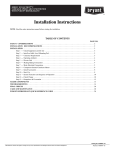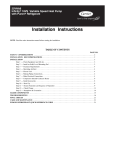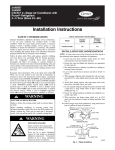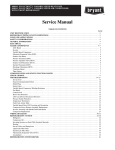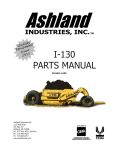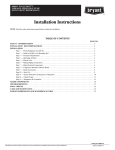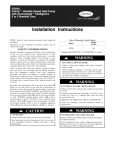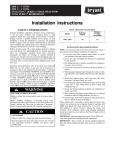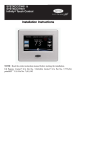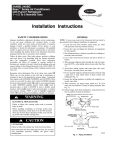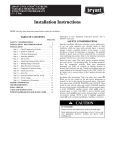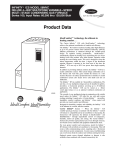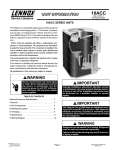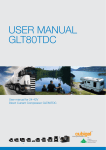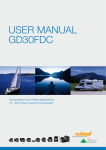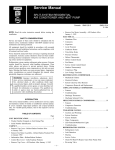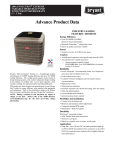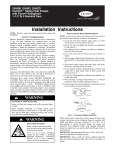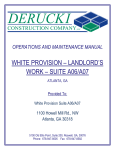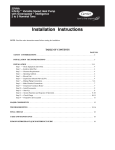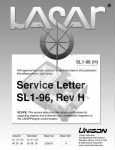Download Installation Instructions
Transcript
24VNA9 Infinityr 19VS Variable Speed Air Conditioner with Puronr Refrigerant Installation Instructions NOTE: Read the entire instruction manual before starting the installation. TABLE OF CONTENTS PAGE NO. SAFETY CONSIDERATIONS . . . . . . . . . . . . . . . . . . . . . . . . . . . . . . . . . . . . . . . . . . . . . . . . . . . . . . . . . . . . . . . . . . . . . . 2 INSTALLATION RECOMMENDATIONS . . . . . . . . . . . . . . . . . . . . . . . . . . . . . . . . . . . . . . . . . . . . . . . . . . . . . . . . . . . . 2 INSTALLATION . . . . . . . . . . . . . . . . . . . . . . . . . . . . . . . . . . . . . . . . . . . . . . . . . . . . . . . . . . . . . . . . . . . . . . . . . . . . . . . . . . 3 Step 1 — Check Equipment and Job site . . . . . . . . . . . . . . . . . . . . . . . . . . . . . . . . . . . . . . . . . . . . . . . . . . . . . . . . . 3 Step 2 — Install on Solid, Level Mounting Pad . . . . . . . . . . . . . . . . . . . . . . . . . . . . . . . . . . . . . . . . . . . . . . . . . . . . 3 Step 3 — Clearance Requirements . . . . . . . . . . . . . . . . . . . . . . . . . . . . . . . . . . . . . . . . . . . . . . . . . . . . . . . . . . . . . . 4 Step 4 — Operating Ambient . . . . . . . . . . . . . . . . . . . . . . . . . . . . . . . . . . . . . . . . . . . . . . . . . . . . . . . . . . . . . . . . . . 4 Step 5 — Elevate Unit . . . . . . . . . . . . . . . . . . . . . . . . . . . . . . . . . . . . . . . . . . . . . . . . . . . . . . . . . . . . . . . . . . . . . . . 4 Step 6 — Making Piping Connections . . . . . . . . . . . . . . . . . . . . . . . . . . . . . . . . . . . . . . . . . . . . . . . . . . . . . . . . . . . 4 Step 7 — Make Electrical Connections . . . . . . . . . . . . . . . . . . . . . . . . . . . . . . . . . . . . . . . . . . . . . . . . . . . . . . . . . . . 5 Step 8 — Compressor Internal Crankcase Heater . . . . . . . . . . . . . . . . . . . . . . . . . . . . . . . . . . . . . . . . . . . . . . . . . . . 8 Step 9 — Install Accessories . . . . . . . . . . . . . . . . . . . . . . . . . . . . . . . . . . . . . . . . . . . . . . . . . . . . . . . . . . . . . . . . . . . 8 Step 10 — Start--Up . . . . . . . . . . . . . . . . . . . . . . . . . . . . . . . . . . . . . . . . . . . . . . . . . . . . . . . . . . . . . . . . . . . . . . . . . . 8 Step 11 — System Functions and Sequence of Operation . . . . . . . . . . . . . . . . . . . . . . . . . . . . . . . . . . . . . . . . . . . . . 9 Step 12 — Check Charge . . . . . . . . . . . . . . . . . . . . . . . . . . . . . . . . . . . . . . . . . . . . . . . . . . . . . . . . . . . . . . . . . . . . . . 10 Step 13 — Pumpdown & Evacuation . . . . . . . . . . . . . . . . . . . . . . . . . . . . . . . . . . . . . . . . . . . . . . . . . . . . . . . . . . . . . 13 MAJOR COMPONENTS . . . . . . . . . . . . . . . . . . . . . . . . . . . . . . . . . . . . . . . . . . . . . . . . . . . . . . . . . . . . . . . . . . . . . . . . . . . 14 TROUBLESHOOTING . . . . . . . . . . . . . . . . . . . . . . . . . . . . . . . . . . . . . . . . . . . . . . . . . . . . . . . . . . . . . . . . . . . . . . . . . . . . . 15 FINAL CHECKS . . . . . . . . . . . . . . . . . . . . . . . . . . . . . . . . . . . . . . . . . . . . . . . . . . . . . . . . . . . . . . . . . . . . . . . . . . . . . . . . . . 20 CARE AND MAINTENANCE . . . . . . . . . . . . . . . . . . . . . . . . . . . . . . . . . . . . . . . . . . . . . . . . . . . . . . . . . . . . . . . . . . . . . . . 20 PURONr REFRIGERANT QUICK REFERENCE GUIDE . . . . . . . . . . . . . . . . . . . . . . . . . . . . . . . . . . . . . . . . . . . . . . . 20 Indoor Thermostat Control Options Information in these installation instructions pertains only to 24VNA9 series units. SAFETY CONSIDERATIONS Improper installation, adjustment, alteration, service, maintenance, or use can cause explosion, fire, electrical shock, or other conditions which may cause death, personal injury, or property damage. Consult a qualified installer, service agency, or your distributor or branch for information or assistance. The qualified installer or agency must use factory--authorized kits or accessories when modifying this product. Refer to the individual instructions packaged with the kits or accessories when installing. Follow all safety codes. Wear safety glasses, protective clothing, and work gloves. Use quenching cloth for brazing operations. Have fire extinguisher available. Read these instructions thoroughly and follow all warnings or cautions included in literature and attached to the unit. Consult local building codes and current editions of the National Electrical Code ( NEC ) NFPA 70. In Canada, refer to current editions of the Canadian electrical code CSA 22.1. Infinity Touch Control Standard Thermostat 24VNA9 Yes* Yes** * Requires model SYSTXCCUITN01 or SYSTXCCUITW01 with version 11 . . . software or newer. ** Using standard thermostat limits functionality of system ! Failure to follow this warning could result in personal injury or death. Electrical components may hold charge. DO NOT remove control box cover for 2 minutes after power has been removed from unit. PRIOR TO TOUCHING ELECTRICAL COMPONENTS: Verify zero (0) voltage at inverter connections shown on inverter cover. ! Failure to follow this warning could result in death, serious personal injury, and/or property damage. Never use air or gases containing oxygen for leak testing or operating refrigerant compressors. Pressurized mixtures of air or gases containing oxygen can lead to an explosion. CUT HAZARD Sheet metal parts may have sharp edges or burrs. Use care and wear appropriate protective clothing and gloves when handling parts. ! WARNING UNIT OPERATION AND SAFETY HAZARD Failure to follow this warning could result in personal injury or equipment damage. PuronR refrigerant systems operate at higher pressures than standard R--22 systems. Do not use R--22 service equipment or components on PuronR refrigerant equipment. ! WARNING ELECTRICAL SHOCK HAZARD Failure to follow this warning could result in personal injury or death. Before installing, modifying, or servicing system, main electrical disconnect switch must be in the OFF position. There may be more than 1 disconnect switch. Lock out and tag switch with a suitable warning label. WARNING EXPLOSION HAZARD CAUTION Failure to follow this caution may result in personal injury. WARNING ELECTRICAL HAZARD -- HIGH VOLTAGE! Recognize safety information. This is the safety--alert symbol !! When you see this symbol on the unit and in instructions or manuals, be alert to the potential for personal injury. Understand these signal words; DANGER, WARNING, and CAUTION. These words are used with the safety--alert symbol. DANGER identifies the most serious hazards which will result in severe personal injury or death. WARNING signifies hazards which could result in personal injury or death. CAUTION is used to identify unsafe practices which would result in minor personal injury or product and property damage. NOTE is used to highlight suggestions which will result in enhanced installation, reliability, or operation. ! Model Inverter Cover IMPORTANT: The inverter cover should NEVER be removed because there is no reason to remove the inverter cover to access the inverter. The inverter has limited serviceability. Refer to Service Manual for details on field replaceable parts. A replacement cover is provided with a replacement inverter. INSTALLATION RECOMMENDATIONS In some cases noise in the living area has been traced to gas pulsations from improper installation of equipment. 1. Locate unit away from windows, patios, decks, etc. where unit operation sound may disturb customer. 2. In noise sensitive applications (such as bedrooms), when a lineset is mounted to ceiling joists or floor joists, the outdoor unit must be located at least 10 ft (3.05 m) away. If this is not possible, create a line set configuration with enough bends to provide 10 ft (3.05 m) of total line set length outside the dwelling 3. Ensure that vapor and liquid tube diameters are appropriate for unit capacity. 4. Run refrigerant tubes as directly as possible by avoiding unnecessary turns and bends. 5. Leave some slack between structure and unit to absorb vibration. 6. When passing refrigerant tubes through the wall, seal opening with RTV or other pliable silicon--based caulk (see Fig. 1). 2 7. Avoid direct tubing contact with water pipes, duct work, floor joists, wall studs, floors, and walls. 8. Do not suspend refrigerant tubing from joists and studs with a rigid wire or strap which comes in direct contact with tubing (see Fig. 1). 9. Ensure that tubing insulation is pliable and completely surrounds vapor tube. 10. When necessary, use hanger straps which are 1 in. wide and conform to shape of tubing insulation. (See Fig. 1.) 11. Isolate hanger straps from insulation by using metal sleeves bent to conform to shape of insulation. ! CAUTION EQUIPMENT DAMAGE HAZARD Failure to follow this caution may result in equipment damage. If proper lineset routing techniques are not followed, variable speed systems can be susceptible to lineset transmitted noise inside the dwelling and, in extreme cases, tubing breakage. OUTDOOR WALL INSTALLATION Specifications for this unit in residential new construction market require the outdoor unit, indoor unit (including metering device), refrigerant tubing sets, and filter drier listed in pre--sale literature. There can be no deviation. Consult the Service Manual – Air Conditioners and Heat Pumps Using Puron Refrigerant to obtain required unit changes for specific applications and for R--22 retrofit. Step 1 — Check Equipment and Job Site Unpack Unit Move to final location. Remove carton taking care not to damage unit. This unit employs one louver spacer on each of the four sides to prevent louver movement during operation. The louver spacers are trapped between the coil surface and louver at the approximate center of each side (See Fig. 2). This louver spacer should be present and, if dislodged during shipment, must be reinstalled before unit is placed into operation. INDOOR WALL CAULK LIQUID TUBE SUCTION TUBE INSULATION THROUGH THE WALL JOIST HANGER STRAP (AROUND SUCTION TUBE ONLY) INSULATION SUCTION TUBE 1” (25.4 mm) MIN LIQUID TUBE SUSPENSION A07588 Fig. 1 -- Connecting Tubing Installation The outdoor unit contains the correct amount of refrigerant charge for operation with AHRI rated indoor units when connected by 15 ft (4.57 m) of field--supplied or factory accessory tubing. Adjust refrigerant charge by adding or removing the charge to/from the unit depending on lineset length and indoor unit as calculated and displayed on the UI. The user interface (UI) calculates required charge adjustment and total system charge required. For proper unit operation, check refrigerant charge using charging information in the Check Charge section of this instruction. IMPORTANT: Liquid--line size is 3/8--in. OD for all 24VNA9 applications. The maximum allowable equivalent line set length is 100 ft. (30.5 m). IMPORTANT: Always install the factory--supplied liquid--line filter drier. Obtain replacement filter driers from your distributor or branch. A11380a Fig. 2 -- Louver Spacer Location Inspect Equipment File claim with shipping company prior to installation if shipment is damaged or incomplete. Locate unit rating plate on unit corner panel. It contains information needed to properly install unit. Check rating plate to be sure unit matches job specifications. Step 2 — Install on a Solid, Level Mounting Pad If conditions or local codes require the unit be attached to pad, tie down bolts should be used and fastened through knockouts provided in unit base pan. Refer to unit mounting pattern in Fig. 3 to determine base pan size and knockout hole location. For hurricane tie downs, contact distributor for details and PE (Professional Engineer) Certification, if required. On rooftop applications, mount on level platform or frame. Place unit above a load--bearing wall and isolate unit and tubing set from structure. Arrange supporting members to adequately support unit and minimize transmission of vibration to building. Consult local codes governing rooftop applications. Roof mounted units exposed to winds above 5 mph may require wind baffles. Consult the Service Manual -- Residential Split System Air Conditioners and Heat Pumps Using Puron Refrigerant for wind baffle construction. NOTE: Unit must be level to within 2 (3/8 in./ft,9.5 mm/m.) per compressor manufacturer specifications. 3 Step 3 — Clearance Requirements When installing, allow sufficient space for airflow clearance, wiring, refrigerant piping, and service. Allow 24 in. (609.6 mm) clearance to service end of unit and 48 in. (1219.2 mm) (above unit. For proper airflow, a 6--in. (152.4 mm) clearance on 1 side of unit and 12--in. (304.8 mm) on all remaining sides must be maintained. Maintain a distance of 24 in. (609.6 mm) between units. Position so water, snow, or ice from roof or eaves cannot fall directly on unit. On rooftop applications, locate unit at least 6 in. (152.4 mm) above roof surface. ! CAUTION UNIT OPERATION HAZARD Failure to follow this caution may result in equipment damage or improper operation. Locate the unit in such a way that it is stable in all circumstances including adverse weather conditions. Step 6 — Make Piping Connections WARNING ! 3/8--- in. (9.53 mm) Dia. Tie--- down Knockouts in Basepan(2) Places PERSONAL INJURY AND UNIT DAMAGE HAZARD Failure to follow this warning could result in personal injury or death. Relieve pressure and recover all refrigerant before system repair or final unit disposal. Use all service ports and open all flow--control devices, including solenoid valves. View From Top ! A05177 UNIT BASE PAN Dimension in. (mm) 23 X 23 (596 X 596) 31.2 X 31.2 (792 X 792) TIEDOWN KNOCKOUT LOCATIONS in. (mm) A B C 7 ---13/16 (198) 4 ---7/16 (102) 18 ---1/8 (458) 9 ---1/8 (232) 6 ---9/16 (167) 24 ---11/16 (627) UNIT DAMAGE HAZARD Failure to follow this caution may result in equipment damage or improper operation. Do not leave system open to atmosphere any longer than minimum required for installation. POE oil in compressor is extremely susceptible to moisture absorption. Always keep ends of tubing sealed during installation. Fig. 3 -- Tie--down Knockout Locations Step 4 — Operating Ambient The minimum outdoor operating ambient is 40_F (4.4_C) with Infinity Touch Control, 55_F (12.8_C) with non--communicating systems. The maximum outdoor operating ambient is 115_F (46.1_C). Compressor protections will prevent operation below minimum ambient temperature range. The system may operate in cooling up to 125_F (52_C) (52C) with significant reduced capacity cutback above 115_F (46.1_C). Refer to Product Data “Detailed Cooling Capacity” table. Low ambient cooling operation is not currently available. ! CAUTION ! UNIT OPERATION HAZARD Failure to follow this caution may result in equipment damage or improper operation. Do not allow water and/or ice to build up in base pan. CAUTION UNIT DAMAGE HAZARD Failure to follow this caution may result in equipment damage or improper operation. If ANY refrigerant tubing is buried, provide a 6 in. (152.4 mm) vertical rise at service valve. Refrigerant tubing lengths up to 36 in. (914.4 mm) may be buried without further special consideration. Do not bury lines longer than 36 in. (914.4 mm). Step 5 — Elevate Unit Elevate unit per local climate and code requirements to provide clearance above estimated snowfall level and ensure adequate drainage of unit. CAUTION Outdoor units may be connected to indoor section using accessory tubing package or field--supplied refrigerant grade tubing of correct size and condition. For tubing requirements between 80 -- 100 ft. (24.38 -- 30.48 m), capacity and performance losses can occur. Follow the pipe sizing recommendations in the 24VNA9 Product data to manage these losses. This unit shall not be installed with greater than 100 ft (30.48 m) of equivalent line length. Refer to Table 1 for field tubing diameters. No additional accessories are required for line lengths between 80 -- 100 ft. (24.4 -- 30.5 m) on this product. Table 1 – Refrigerant Connections and Recommended Liquid and Vapor Tube Diameters (in.) UNIT SIZE Connection Diameter LIQUID Tube Diameter Connection Diameter VAPOR* Max (Rated) Diameter Minimum Tube Diameter 24VNA924, 24VNA925 24VNA936 24VNA948 3/8 3/8 3/8 3/8 3/8 3/8 3/4 3/4 7/8 7/8 7/8 1 ---1/8 5/8 5/8 3/4 * Units are rated with 25 ft. (7.6 m) of lineset. See Product Data sheet for performance data when using different size and length line sets. Notes: 1. Do not apply capillary tube indoor coils to these units. 4 Outdoor Unit Connected to Factory-- Approved Indoor Unit Outdoor unit contains correct system refrigerant charge for operation with factory--approved, AHRI--rated indoor units when connected by 15 ft. (4.57 m) of field--supplied or factory--accessory tubing, and factory--supplied filter drier. Check refrigerant charge for maximum efficiency. NOTE: If the indoor furnace coil width is more than the furnace casing width, refer to the indoor coil Installation Instructions for transition requirements. Install Liquid-- Line Filter Drier Indoor Refer to Fig. 4 and install filter drier as follows: 1. Braze 5--in. (127 mm) liquid tube to the indoor coil. 2. Wrap filter drier with damp cloth. 3. Braze filter drier to above 5--in. (127 mm) liquid tube. 4. Connect and braze liquid refrigerant tube to the filter drier. CAUTION ! UNIT DAMAGE HAZARD Evacuate Refrigerant Tubing and Indoor Coil CAUTION ! UNIT DAMAGE HAZARD Failure to follow this caution may result in equipment damage or improper operation. Never use the system compressor as a vacuum pump. Refrigerant tubes and indoor coil should be evacuated using the recommended deep vacuum method of 500 microns. The alternate triple evacuation method may be used. See Service Manual for triple evacuation method. Always break a vacuum with dry nitrogen prior to opening the refrigerant system for servicing. Deep Vacuum Method The deep vacuum method requires a vacuum pump capable of pulling a vacuum of 500 microns and a vacuum gauge capable of accurately measuring this vacuum depth. The deep vacuum method is the most positive way of assuring a system is free of air and liquid water. (See Fig. 5) 5000 4500 Failure to follow this caution may result in unit damage or improper operation. 4000 3500 3000 2500 LEAK IN SYSTEM MICRONS Installation of filter drier in liquid line is required. 2000 1500 1000 VACUUM TIGHT TOO WET TIGHT DRY SYSTEM 500 0 1 2 3 4 5 MINUTES 6 7 A95424 A95424 Fig. 5 -- Deep Vacuum Graph Final Tubing Check Refrigerant Tubing connection Outdoor IMPORTANT: Check to be certain factory tubing on both indoor and outdoor unit has not shifted during shipment. Ensure tubes are not rubbing against each other or any sheet metal. Pay close attention to feeder tubes, making sure wire ties on feeder tubes are secure and tight. Connect vapor tube to fitting on outdoor unit vapor service valves (see Table 1). Step 7 — Make Electrical Connections A05178 Fig. 4 -- Liquid--Line Filter Drier Sweat Connections ! ! CAUTION ELECTRICAL SHOCK HAZARD UNIT DAMAGE HAZARD Failure to follow this warning could result in personal injury or death. Failure to follow this caution may result in equipment damage or improper operation. Do not supply power to unit with compressor terminal box cover removed. S Use a brazing shield S Wrap service valves with wet cloth or heat sink material. Use refrigerant grade tubing. Service valves are closed from factory and ready for brazing. After wrapping service valve with a wet cloth, braze sweat connections using industry accepted methods and materials. Consult local code requirements. Refrigerant tubing and indoor coil are now ready for leak testing. This check should include all field and factory joints. WARNING Be sure field wiring complies with local and national fire, safety, and electrical codes, and voltage to system is within limits shown on unit rating plate. Contact local power company for correction of improper voltage. See unit rating plate for recommended circuit protection device. NOTE: Operation of unit on improper line voltage constitutes abuse and could affect unit reliability. See unit rating plate. Do not 5 install unit in system where voltage may fluctuate above or below permissible limits. NOTE: Use copper wire only between disconnect switch and unit. NOTE: Install branch circuit disconnect of adequate size per NEC to handle unit starting current. Locate disconnect within sight from and readily accessible from unit, per Section 440--14 of NEC. Route Ground and Power Wires Remove access panel to gain access to unit wiring. Extend wires from disconnect through power wiring hole provided and into unit control box. WARNING ! ELECTRICAL SHOCK HAZARD Failure to follow this warning could result in personal injury or death. The unit cabinet must have an uninterrupted or unbroken ground to minimize personal injury if an electrical fault should occur. The ground may consist of electrical wire or metal conduit when installed in accordance with existing electrical codes. Connect Ground and Power Wires Connect ground wire to ground connection in control box for safety. Connect power wiring to contactor as shown in Fig. 6. DISCONNECT PER N. E. C. AND/OR LOCAL CODES Connect Control Wiring-- Infinity Touch Connect to Infinity connections. Only two wires (AB) to Infinity capable indoor unit (furnace or fan coil) are required. Connect C if additional grounding is required (see Fig. 7). IMPORTANT: This system requires the power supplied to the outdoor unit, and the indoor unit, for the UI to communicate with the outdoor unit. Connect Control Wiring-- Non-- Communicating 4 wires are required when connecting 24VNA9 models to non--communicating 2--stage thermostats. Use Fig. 8 For required connections. Unit is configured by factory for Infinity communicating control. To wire unit for non--communicating control, disconnect the green (A) and yellow (B) wires from ABCD plug and connect appropriate wires to low voltage terminal block. Use wire nuts to attach thermostat wire to LVCH harness. General Information Use No. 18 AWG or larger color--coded, insulated (35C minimum) wire for low voltage control wires. All wiring must be NEC Class 2 and must be separated from incoming power leads. Use furnace transformer, fan coil transformer, or accessory transformer for control power requirement of system accessories external to the OD unit. The outdoor unit has its own transformer power. Final Wiring Check IMPORTANT: Check factory wiring and field wire connections to ensure terminations are secured properly. Check wire routing to ensure wires are not in contact with tubing, sheet metal, etc. TERMINAL BLOCK Furnace or Fan Coil 24VNA9 D D D C C C B B B A A A User Interface (UI) FIELD POWER WIRING FIELD GROUND ’C’ connection optional GROUND LUG OAT WIRING A14028 C HUM 24vac C W Humidifier O Y R Fig. 6 -- Line Power Connections A11144AC Fig. 7 -- Infinity Furnace or Fan Coil Wiring with Communicating Variable Speed AC 6 Thermidistat Fan Coil A/C O O W1 RVS Cooling O/B W2 W1 Heat Stage 3 W/W1 W2 Heat/Cool Stage 1 Y1 / W2 Y1 Y1 Heat/Cool Stage 2 Y/Y2 Y/Y2 Y2 Fan G G 24VAC Hot Heating Rh R 24VAC Hot Cooling Rc Dry Contact 1 D1 Dry Contact 2 D2 DH 24VAC Common C C Humidify HUM Outdoor Air Temp OAT Remote Room Sensor RRS OAT/RRS Com SRTN Jumper Wire Required for Single-Stage R J1 Jumper on Control Board C Humidifier Solenoid Valve Outdoor Sensor Remote Room Sensor A14269AC Thermidistat Furnace A/C O RVS Cooling O/B W2 W2 Heat Stage 3 (furnace) W/W1 W/W1 W1 Heat/Cool Stage 1 Y1 / W2 Y1 Y1 Heat/Cool Stage 2 Y/Y2 Y/Y2 Y2 Fan G G 24VAC Hot Heating Rh R 24VAC Hot Cooling Rc Dry Contact 1 D1 Dry Contact 2 D2 DHUM 24VAC Common C COM Humidify HUM Outdoor Air Temp OAT Remote Room Sensor RRS OAT/RRS Com SRTN Jumper Wire Required for Single-Stage R J1 Jumper on Control Board C Humidifier Solenoid Valve Outdoor Sensor Remote Room Sensor Fig. 8 -- Low Voltage Wiring (Non--Communicating) 7 A14029AC Step 8 — Compressor Crankcase Heater Step 10 — Start--Up This compressor has an internal crankcase heater. Furnish power to the unit a minimum of 24 hours before starting the unit for the first time. To furnish power to heater only, set thermostat to OFF and close electrical disconnect to outdoor unit. Power is not required to the indoor unit or User Interface for proper operation of heater. Crankcase heater will be intelligently energized as needed between operations, even when the UI or thermostat and indoor unit is not installed, as long as there is power to the outdoor unit. ! UNIT OPERATION AND SAFETY HAZARD Failure to follow this caution may result in minor personal injury, equipment damage or improper operation. Observe the following: 1. Do not overcharge system with refrigerant. 2. Do not operate unit in a vacuum or at negative pressure. 3. Do not disable low pressure transducer or high pressure. 4. Dome temperatures may be hot. Airflow Setup for Infinity Touch Control Furnace or FE Fan Coil (communicating) This system can only be installed with Infinity--capable indoor and Infinity Touch User Interface (UI) SYSTXCCUITN01 or SYSTXCCUITW01 with version 11 software or newer. When using an Infinity Touch User Interface, airflow is automatically selected based on equipment size. The user has the option of selecting Comfort, Efficiency and Max airflow for Cooling modes. These should be selected based on balance between the homeowner’s comfort and energy consumption expectations. See User Interface Installation Instructions for additional available adjustments. Due to using a communicating control with the fan coil or the furnace, dip switch adjustments are not necessary. The outdoor unit configuration and the indoor airflows are determined by communicating control setup. ! CAUTION PERSONAL INJURY HAZARD Failure to follow this caution may result in personal injury. Wear safety glasses, protective clothing, and gloves when handling refrigerant. ! CAUTION ENVIRONMENTAL HAZARD Failure to follow this caution may result in environmental damage. Airflow Setup for Non--communicating Fan Coil The system can be installed with a standard 2--stage thermostat and FV4C fan coil without additional accessories. Select appropriate unit size on fan coil Easy select board. NOTE: FK4 and 40FK require a TXV change. See accessory list for approved TXV. CAUTION Federal regulations require that you do not vent refrigerant to the atmosphere. Recover during system repair or final unit disposal. Follow these steps to properly start up the system: Airflow Setup for Non--communicating Furnaces 1. After system is evacuated, close the disconnects to energize the ID and OD units to access the user interface (UI), Keep system in off mode. Under the Advanced function menu, on the Infinity Touch Control, access the REQUIRED CHARGE CALCULATION screen. Enter the lineset length and vapor tube diameter. The user interface (UI) will now display the required charge adjustment (see Fig. 10 for example) for the lineset and an adjustment for a large indoor coil if recognized as such by the UI. 2. Add or remove the required charge adjustment for lineset length to liquid service valve. Note: If lineset is less than 15 feet (--9.4_C), charge removal may be necessary. 3. Fully open liquid and vapor service valves. For installations with non--communicating furnaces, set airflows to 350--400 cfm/nominal ton in high stage and 70--80 percent of high stage airflow in low stage. Step 9 — Install Accessories No refrigeration circuit accessories are required or are available for installation within the unit. External to the unit, the same accessories such as support feet, snow rack, wind baffle etc., available on other Carrier units, can also be used on this line of product. For models utilizing 23 inch x 23 inch base pans, it is recommended to use 5 support feet in order to fully support unit. See Fig. 9. Refer to the individual Installation Instructions packaged with kits or accessories when installing. A14019 Fig. 9 -- Recommended Support Feet Location Fig. 10 -- Required Charge Adjustment Calculated in UI A14008 4. Set User Interface to operate cooling in CHARGING mode. Charging mode operates system compressor speed and fan speeds to proper conditions to check the refrigerant charge. 8 NOTE: See Step 13 for charging check. 5. Wait for the specified stabilization time, depending on lineset length. Compare subcooling at liquid line service valve to Liquid Line Subcooling Target as shown CHARGING screen (LiqLin SC TGT) (see Fig. 11 for example). Fig. 11 -- Liquid Line Subcooling Target A14020 Step 11 — System Functions and Sequence of Operation The 24VNA9 models utilize either Infinity Touch Communicating User Interface (UI) or conventional thermostat. When using UI controls, a call for cooling will energize the outdoor fan and compressor to run at lowest cooling demand. If this does not satisfy cooling demand, the system will ramp up in stages until it satisfies the demand. After coping with the higher demand, the unit returns to lower capacity operation until the demand is satisfied or until an increase in demand. When using a conventional thermostat, the thermostat controls the staging of outdoor unit. When all demand is satisfied, the compressor will shut off. As the unit operates at lower capacity, system vapor (suction) pressure will be higher than it is during a standard single--stage system operation or during a higher capacity operation. The user interface (UI) displays the operation mode and fault codes as specified in the troubleshooting section. See Table 6 for codes and definitions. The conventional thermostat inputs are designed to work with most indoor units. See AHRI for approved combinations. Connections are Y/Y2, Y1, R and C. Depending on thermostat and indoor unit, the system will operate at 1 or 2 capacities in cooling mode. NOTE: Only one code will be displayed on the outdoor unit control board (the most recent, with the highest priority). The latest codes are stored and can be accessed via the UI. Upon a call for cooling through the UI (or the Y1 and/or Y2 connections in a non--communicating system), the Application Operation Control (AOC) board (see Fig. 15) will request a compressor speed and outdoor fan motor speed based on the indoor space demand and outdoor conditions. If the conditions are correct for operation, the control board will allow the requested operation to begin, but if the control board determines that the conditions are not correct, the board will decide what other operation nearing that condition is acceptable. The inverter Motor Operational Control (MOC) then outputs the three--phase PWM signal and frequency that gently ramps the compressor speed up to stage 2, and then will adjust to the demanded speed. The gentle ramp--up results in no locked rotor amps to the compressor motor. The unit nameplate for compressor LRA will be stamped N/A (not applicable). During operation, the AOC monitors itself and the compressor operation along with the system pressures and temperatures. The MOC board monitors the temperature, current and operational status of the compressor, OD fan and the inverter itself. During operation, the compressor speed will be adjusted to meet the changes to the demand. When the demand is satisfied, the inverter will ramp--down the compressor speed and stop. When the compressor stops, a 3.5 minute Time Guard period is activated which is followed by opening of the PEV valve for 150 seconds to equalize the refrigerant pressure difference between the high and low sides of the compressor. Upon equalizing the refrigerant pressure, and an additional 15 seconds of the Time Guard period, the compressor will be ready for the next operational demand. If there is a power cycle, the Pressure Equalizer Valve (PEV) will open for 150 seconds before the compressor start--up. Opening the PEV valve returns the discharge gas directly back to the suction side of the compressor. This is done so the rotary compressor will start with a very low pressure differential. The 3.5 minute Time Guard can be bypassed by momentarily shorting the Forced Defrost pins. Only the 3.5 minute time delay can be bypassed. Because it is important for compressor reliability, the 150--second PEV delay cannot be bypassed. Crankcase Heater Operation This unit has an internal crankcase heater that will be energized during the off cycle and is intelligently demanded by the system to prevent the compressor from being the coldest part of the system thus enhancing the reliability. The crankcase heater will function as needed any time the outdoor unit is powered. The indoor unit and UI do not need to be installed for the crankcase heater to operate properly. The compressor windings will occasionally be energized during the OFF cycle (depending on the length of the OFF cycle) to start the stator heat operation, thus maintaining a sump temperature that is essential for compressor reliability. The compressor will not run during this process. Outdoor Fan Motor Operation The outdoor unit control energizes outdoor fan anytime the compressor is operating. The OD fan motor is variable speed. The speed will change depending on the ambient temperature and the cooling capacity required. Time Delays The unit time delays include: S 3.5 minute time delay after last cycle, initial power up, return from brown--out condition. To bypass this feature, momentarily short and release Forced Defrost pins. S At the end of every compressor ON cycle, there will be 150 seconds of PEV open period for pressure equalization followed by 15 seconds of PEV Off period before the next compressor ON cycle. This delay cannot be bypassed as it helps compressor reliability. S 15 second delay at termination of defrost before the auxiliary heat is de--energized. S See Table 6 for other delay information. Communication and Status Function Lights Infinity Touch Control, Green Communications (COMM)Light A green LED (COMM light) on the outdoor board indicates successful communication with the other system products. The green LED will remain OFF until communication is established. Once a valid command is received, the green LED will turn ON continuously. If no communication is received within 2 minutes, the LED will be turned OFF until the next valid communication. The green LED will be turned off when using a standard 2--stage non--communicating thermostat. Amber Status Light Amber colored STATUS light indicates operation and error status. See Table 6 for definitions. S Two minute time delay to return to standby operation from last valid communication. 9 Step 12 — Check Charge Charge in CHARGING mode (communicating only) Factory charge amount and desired subcooling are shown in the user interface (UI). To properly check or adjust charge, conditions must be favorable for subcooling charging in cooling mode. Favorable conditions exist when the outdoor temperature is between 65_F and 100_F (18_C and 38_C), and the indoor temperature is between 70_F and 80_F (21_C and 27_C). If the temperatures are outside of these ranges, weigh--in charge only. If charge confirmation is needed return to check subcooling in cooling mode when between 65_F (18.3_C) and 100_F (37.8_C). Charging Procedure: Unit is factory charged for 15ft (4.57 m) of lineset. If any refrigerant charge adjustment is required due to the user inputted line set length, the UI will calculate and display the target subcooling and the amount of additional charge to be added. Therefore, the UI is your source of information for charging the system correctly. Refrigerant charge adjustment amount for adding or removing 0.6 oz/ft (17.74 g/m) of 3/8 liquid line above or below 15ft (4.57 m) respectively. Perform a final charge check only when in cooling and OD is between 65_F (18_C) and 100_F (38_C). NOTE: UI indicates acceptable conditions if outside of this range. Do not charge if outside 65_F (18_C) and 100_F (38_C) outdoor temperature. If the range is acceptable, go the CHARGING screen in the user interface (UI). At cooling conditions, set the user interface (UI) to check the charge in cooling mode. Allow system to operate in cooling mode for the stabilization period as indicated in the user interface (UI). Once conditions are indicated as favorable and stable by the user interface (UI), check the system charge by subcooling method. Compare the subcooling taken at the liquid service valve to the subcooling target (LiqLin SC TGT) listed on the charging screen. Add refrigerant if the subcooling is low and remove charge if subcooling is high. Tolerance should be ±2_F. If any adjustment is necessary, add or remove the charge slowly (no greater than 0.5 lb per minute) and allow system to operate for 25 minutes to stabilize before declaring a properly charged system. The use of a commercial charge metering device (restrictor) such as Imperial liquid low side charger model 535--C or Watsco ChargeFaster model CH200 is recommended when adding refrigerant to an operating system. This prevents potential damage of liquid slugging of the compressor and allows the subcooling to stabilize quicker. If the indoor temperature is above 80_F (26.67_C), and the outdoor temperature is in the favorable range, adjust system charge by weight based on line length and allow the indoor temperature to drop to 80_F (26.67_C) before attempting to check system charge by subcooling method as described above. If the indoor temperature is below 70_F (21.11_C), or the outdoor temperature is not in the favorable range, adjust charge for line set length above or below 15ft (4.57 m) and indoor fan coil / furnace coil per Table 2. Charge level should then be appropriate for the system to achieve rated capacity. The charge level could then be checked at another time when the both indoor and outdoor temperatures are in a more favorable range. This ensures maximum efficiency and reliability. Charging Non-- Communicating Systems Charging Procedure: Force system to operate in high stage cooling by creating a large differential between room temperature and set point on thermostat. Use multi--meter to verify that 24 VAC is present between C, Y1 /Y2 terminals at outdoor unit. Factory charge amount is shown on unit rating plate for high stage. Target subcooling chart is provided on back of control box door see Fig. 12 -- 14 for example. To properly check or adjust charge, condition must be favorable for subcooling charging. Favorable conditions exists when outdoor temperature is between 65_F (18_C) and 100_F (38_C), and the indoor temperature is between 70_F (21_C) and 80_F (27_C). Follow the procedure below: Unit is factory charged for 15ft (4.57 m) of lineset. Adjust charge by adding or removing 0.6 oz/ft (17.7 g/m) of 3/8 liquid line above or below 15ft (4.57 m) respectively. For standard refrigerant line lengths (80ft/24.4 m or less), allow system to operate in cooling mode at least 25 minutes. If conditions are favorable, check system charge by subcooling method. If any adjustment is necessary, adjust charge slowly and allow system to operate for 25 minutes to stabilize before declaring a properly charged system. If the indoor temperature is below 70°F (21.11°C), or the outdoor temperature is not in the favorable range, adjust charge for line set length above or below 15ft (4.57 m) and indoor fan coil /furnace coil per Table 4. Charge level should then be appropriate for the system to achieve rated capacity. The charge level should then be checked at another time when the both indoor and outdoor temperatures are in a more favorable range. NOTE: If the line length is beyond 80ft (24.38 m) or greater than 20ft (6.10 m) vertical separation see Long line guideline for special charging requirement. 10 Table 2 – Required Charge Adjustment for Indoor Coil Model 24VNA9 Furnace or Fan Coil Model Number 24 & 25 CNP**24 --- CSPH*24 --- CAP**24 --- F(E,V)4(A,B,C)NF002 --- --- F(E,V)4(A,B,C)N(B,F)003 +.5 --- CAP**30 +.5 --- CNP**30 +.5 --- 36 CAP**36 +.5 --- CNP**36 +.5 --- CSPH*36 +.5 --- CNP**42 +.5 --- CAP**42 +.5 --- CNP**48 48 --- --- CNP**37 +1.25 +.75 --- CNP**43 +1.25 +.75 --- +.75 --- CAP**48 CNP**60 --- CSPH*60 --- CAP**60 +1.5 F(E,V)4(A,B,C)N(B,F)005 +1.25 +.75 +1.5 CNP**61 +1.5 F(E,V)4(A,B,C)NB006 +1.5 11 - 24, 25 Fig. 12 -- Charging in Cooling Mode 24VNA924/25 Fig. 13 -- Charging in Cooling Mode 24VNA936 Fig. 14 -- Charging in Cooling Mode 24VNA948 12 Step 13 — Pumpdown & Evacuation ! CAUTION ENVIRONMENTAL HAZARD Failure to follow this caution may result in environmental damage. Federal regulations require that you do not vent refrigerant to the atmosphere. Recover during system repair or final unit disposal. If this system requires either a Pump Down or Evacuation for any reason, the procedures below must be followed: Pump Down - Infinity Communicating Because this system is inverter controlled, compressor, suction pressure transducer, conventional procedure cannot be used to “pump down” and isolate the refrigerant into the outdoor unit. The UI (User Interface) has provisions to assist in performing this function. 1. Connect gauges to 24VNA9 liquid and vapor service valve ports to monitor operating pressures during and at completion of the procedure. 2. In the advanced menu of the UI, go to Checkout > Pumpdown 3. Select mode to pump down in (COOL). Set desired time period. Default time period for the procedure is 120 minutes. 4. Select Start on UI to begin the pump--down process. Unit will begin running in selected mode after a brief delay. 5. Close the liquid service valve. 6. The unit will run in selected mode with the low pressure protection set to indicate pump--down is complete when the suction pressure drops below 10 psig. Compressor protections are still active to prevent damage to the compressor or inverter (high pressure, high current, high torque, etc.) . 7. Once system indicates pump--down complete or failure to complete shutdown, close vapor service valve. 8. A small quantity of charge will remain in isolated section of system dependent on ambient temperature and overall system charge. This charge must be manually recovered. A recovery system will be required to remove final quantity of refrigerant from indoor coil and line set. 9. Remove power from indoor and outdoor unit prior to servicing unit. Pump Down – Using 2-- stage Thermostat (Non-- Communicating) Because this system has an inverter controlled compressor, suction pressure transducer, conventional procedure cannot be used to “pump down” and isolate the refrigerant into the outdoor unit. 1. Connect gauges to 24VNA9 liquid and vapor service valve ports to monitor operating pressures during and at completion of the procedure. 2. Force system to operate in high stage by creating a large differential between room temperature and set point on thermostat. Use multi--meter to verify that 24 VAC is present between C and Y1 and Y2 terminals at outdoor unit. 3. Close the liquid service valve. 4. The unit will continue to run until high or low pressure switches open. Close vapor service valve once compressor shuts down. 5. Remove power from indoor and outdoor unit prior to servicing unit. 6. A quantity of charge will remain in isolated section of system dependent on ambient temperature and overall system charge. This charge must be manually recovered. A recovery system will be required to remove final quantity of refrigerant from indoor coil and line set. Evacuation and recovery of refrigerant from 24VNA9 1. Connect gauges to 24VNA9 liquid and vapor service valve ports to monitor operating pressures during and at completion of the procedure. Attach recovery system or vacuum pump to gauge set as needed for the service procedure. The service valves must be open to evacuate the unit through the line set service ports. Evacuation and recovery of refrigerant from 24VNA9 when using non-- communicating thermostat 1. Connect gauges to 24VNA9 liquid and vapor service valve ports to monitor operating pressures during and at completion of the procedure. Attach recovery system or vacuum pump to gauge set as needed for the service procedure. The service valves must be open to evacuate the unit through the line set service ports. 13 MAJOR COMPONENTS Variable Speed Compressor This unit contains a variable speed rotary compressor that has a wide operating range. It operates on a variable 3 phase sine wave provided by the inverter. This compressor can only be operated by the specific inverter supplied with the unit. Variable speed Control Board ! CAUTION EQUIPMENT DAMAGE HAZARD Failure to follow this caution may result in equipment damage and/or improper operation. Do not attempt to apply line voltage directly to the compressor. This will destroy the compressor. Field control Connections For communicating operation use the communication Infinity plug only. Only two wires, AB (color), are required. If necessary, connect C for additional grounding (see Fig. 7). If using standard 2--stage thermostat, connect discrete inputs (R,C,Y2,Y1) for 2--stage control in cooling modes. Pressure Transducer (SPT) A13361 Fig. 15 -- AOC (Application Operational Control) Board The AOC board is located in the lower right hand side of inverter tray. It’s functions include: S Compressor speed control S Outdoor fan motor control S Crankcase heater operation S Pressure switch monitoring S Time Delays S Pressure Transducer measurements S PEV control (pressure equalizer valve) S Temperature measurements S Inverter communication and control Inverter A 5 VDC output low pressure transducer that provides a 0--5 VDC data for interpretation by the control board for a 0 to 200 psig range of pressure at the suction tube. This interpreted pressure data is then intelligently used by the AOC control board for low pressure cut--out, loss of charge management, compressor protection, oil circulation management, and lubrication management. Pressure Equalizer Valve (PEV) At the end of every compressor operation (after the 3.5 minute Time Guard period), the equalizer valve opens for 150 seconds plus an additional 15 seconds of protection before allowing the compressor to start ramping up. The PEV is located next to the suction and discharge of the compressor. The function of this valve is to prevent the compressor from starting with a high refrigerant pressure differential, thus helping the reliability of the compressor. NOTE: A hissing sound may be heard during the equalization process. This is normal. The inverter is located inside the control box. This is an air--cooled device that communicates with the control board and drives the compressor and fan motor to the demanded RPM. The inverter is always powered with line voltage since no contactor is used. The inverter changes the line voltage to DC volts and then recreates 3 phase sine waves that vary in frequency to drive the compressor and fan motor at the desired RPM. NOTE: The unit may be operated with an Infinity Touch Control or a standard 2--stage thermostat. Infinity Touch Control will utilize 5 stages cooling, while 2--stage thermostat will only allow 2 discrete stages of cooling operation. 14 TROUBLESHOOTING Systems Communication Failure If communication is lost with the User Interface (UI), the control will flash the appropriate fault code (see Table 6). Check the wiring to the User Interface and the indoor and outdoor units and power. Model Plug Each control board contains a model plug. The correct model plug must be installed for the system to operate properly (see Table 3). The model plug is used to identify the type and size of unit to the control. On new units, the model and serial numbers are inputted into the AOC board’s memory at the factory. If a model plug is lost or missing at initial installation, the unit will operate according to the information input at the factory and the appropriate error code will flash temporarily. An RCD replacement AOC board contains no model and serial information. If the factory control board fails, the model plug must be transferred from the original board to the replacement board for the unit to operate. When installing AC unit with older fan coils, a model plug change may be required. See table NO TAG for fan coils requiring model plug change. NOTE: The model plug takes priority over factory model information input at the factory. If the model plug is removed after initial power up, the unit will operate according to the last valid model plug installed, and flash the appropriate fault code temporarily. Table 3 – Factory Supplied Model Plug Information MODEL NUMBER MODEL PLUG NUMBER 24VNA924 24VNA925 PIN RESISTANCE (K--- ohms) Pins 1--- 4 Pins 2--- 3 HK70EZ011 5.1K 120K 24VNA936 HK70EZ012 5.1K 180K 24VNA948 HK70EZ013 5.1K 220K connect the C and D wires from the service tool to the two terminals of the 120VAC to 24VAC adapter (0.5Amp minimum) as shown in Fig. 16. When the service tool is connected and powered up, the communicating controls inside the home will ”go to sleep” and let the service tool take control of the system. In this manner, the service technician can run the diagnostic checkouts right at the outdoor unit using the service tool. After the checkouts are completed and it is no longer necessary to use the service tool, remove it from the communicating controls and the indoor communicating controls will regain control in about two minutes. Pressure Switch Protection The outdoor unit is equipped with high pressure switch. If the control senses the opening of a high pressure switch (open 600+/--5 psig, close 470+/--10 psig @77_F), it will respond as follows: 1. Display the appropriate fault code (see Table 6). 2. After a 15 minute delay, if there is a call for cooling and HPS is reset, the PEV opens for 150 seconds to equalize system pressures. The compressor and fan will then ramp to the next lower stage of operation until demand is satisfied. In the next call for cooling system will resume normal operation. 3. If the opened switch closes at any time after the 15 minute delay, then the PEV opens for 150 seconds to equalize system pressures. The compressor and fan will then ramp to the next lower stage of operation until demand is satisfied. In the next call for cooling system will resume normal operation. 4. If HPS trips 3 consecutive cycles, the unit operation is locked out for 4 hours. 5. In the event of a high--pressure switch trip or high--pressure lockout, check the refrigerant charge, outdoor fan operation, and outdoor coil (in cooling) for airflow restrictions. 6. In the event of a low--pressure trip or low--pressure lockout, check the refrigerant charge and indoor airflow (cooling). Control Fault Service Tool If the outdoor unit control board has failed, the control will flash the appropriate fault code (see Table 6). The control board should be replaced. Brown-- Out Protection Connect to 120VAC to 24vac (0.5A min.) adapter If the line voltage is less than 187V for at least 4 seconds, the Compressor and OD fan goes to 0 rpm. Compressor and fan operation are not allowed until voltage is a minimum of 190V. The control will flash the appropriate fault code (see Table 6). 230V Line (Power Disconnect) Detection Fig. 16 -- Service Tool Connection A14178 When working on the outdoor unit of a split system, the technician would usually need to repeatedly walk between the indoor wall control and the unit outside. To save time, the communicating controls offer a service tool feature. By wiring the service tool into the AOC board and powering it with an external adapter, the technician can have a wall control capable of running the system right at the outdoor unit. To use a service tool, connect the A and B communication bus wires from this second communicating control to the terminals marked A and B on the terminal strip located in the bottom left corner of the AOC board (see Fig. 16). But instead of connecting the wires on the service tool to the terminals marked C and D, The control board senses the presence of absence of 230V through inverter feedback. Voltage should present at all times when system is in service regardless if system is running or standby. If there is no 230V at the inverter when the indoor unit is powered with a cooling demand, the appropriate fault code is displayed on UI (communicating only – see Table 6). If system is configured with conventional thermostat (non--communicating), no fault code will be displayed on AOC board, nor will any status LEDs be lit. Use multimeter to check for the presence of 230V in this situation. Temperature Thermistors Thermistors are electronic devices which sense temperature. As the temperature increases, the resistance decreases. 10Kohm thermistors are used to sense outdoor air temperature (OAT), coil temperature (OCT) and the suction line temperature (OST) located between the reversing valve and the accumulator. A 50Kohm thermistor is used to sense discharge temperature (ODT). Refer to Table 4 and Fig. 17 and 18 for resistance values versus temperature. 15 Table 4 – 10K/50Kohm Resistance Values vs Temperature 10Kohm _C (_F) TEMPERATURE 25.0 (77.0) 0.0 (32.0) -28.0 (-18.4) The control continuously monitors and compares the outdoor air temperature sensor and outdoor coil temperature sensor to ensure proper operating conditions. The comparison is: S In cooling if the outdoor air sensor indicates 10_F ( 5.6_C) warmer than the coil sensor (or) the outdoor air sensor indicates 25_F ( 12_C) cooler than the coil sensor, the sensors are out of range. If the sensors are out of range, the control will flash the appropriate fault code as shown in Table 6. The thermistor comparisons are not performed during low ambient cooling. RESISTANCE (ohms) 10.0 + / --- 2.3% 32.6 + / --- 3.2% 85.5 + / --- 3.4% 50Kohm 125.0 (257.0) 75.0 (167.0) 25.0 (77.0) 1.7 + / --- 1.6% 7.40 + / --- 2.0% 50.0 + / --- 2.3% THERMISTOR CURVE Outdoor Coil Thermistor 90 The outdoor coil thermistor is a 10Kohm resistor used for multiple system operations. It provides the coil/liquid line temperature to the AC unit board and user interface. Low ambient operation, and assistance with OAT temperature measurement are some of the functions. The sensor must be securely mounted to the tube connecting the coil and distributor. See Fig. 20 for proper placement. See Table 4 for proper resistances. 80 RESISTANCE (KOHMS) Thermistor Sensor Comparison 70 60 50 40 30 20 10 0 0 20 40 60 80 TEMPERATURE (DEG. F) 100 120 A91431 Fig. 17 -- 10K Thermistor Resistance Versus Temperature RESISTANCE (KOHMS) 50K THERMISTOR 450 400 350 300 250 200 150 100 50 0 0 20 40 60 80 100 120 A14328 TEMPERATURE (°°F) Fig. 19 -- Outdoor Coil Thermistor (OCT) Attachment (On Distributor Tube) A14022 Fig. 18 -- 50K Thermistor Resistance Versus Temperature OAT Thermistor must be locked in place with spherical nib end facing towards the front of the control box If the outdoor air or coil thermistor should fail, the control will flash the appropriate fault code (see Table 6). IMPORTANT: The outdoor air thermistor, coil thermistor and suction thermistor should be factory mounted in the final locations. Check to ensure thermistors are mounted properly (See Fig. 19, 20, 21 and 22). A11142 Fig. 20 -- OAT Thermistor Location (Bottom of Control Box) 16 Suction Thermistor (OST) Variable Speed Compressor Winding Resistance Suction Thermistor is used to accurately measure suction temperature and must be secured on the suction tube and aligned longitudinally to the vertical surface of the tube axis (see Fig. 21). This compressor operates with 3--phase variable frequency PWM variable voltage. For troubleshooting certain fault codes related to compressor resistances, follow these steps: 1. Disconnect compressor power leads from the inverter MOC terminals, U (YEL), V (RED), and W (BLK). 2. Measure the resistance between YEL to RED, YEL to BLK, and RED to BLK and compare to Table 5 values. Each resistance set should be equal. 3. Measure the resistance to ground for each lead. 4. If the resistances check out, reconnect power leads to appropriate terminal. 5. If the resistances appear to be abnormal, it will be necessary to measure the resistance at the compressor fusite terminals. 6. During the removal of the compressor fusite cap, do not remove the RTV sealant. Remove the harness plug, measure the resistances, and compare to Table 5. 7. Special care will need to be taken with the replacement of the compressor fusite cap. Make sure the two holes in the compressor fusite terminal box are still full of RTV sealant before the cap is reinstalled. The factory RTV can be reused as long as none of it has been removed during the cap removal. 8. Reinstall compressor sound blanket making sure discharge thermistor and compressor power harness are routed as they were from the factory ! CAUTION UNIT DAMAGE HAZARD Failure to follow this caution may result in equipment damage or improper operation. In order to minimize the ambient influence, make sure the thermistor curved surface hugs the pipe surface and is secured tight using the wire tie fished through the original slot insulating polymer body. Table 5 – Variable Speed Compressor Resistance (winding resistance at 70_F 20_F) A14023 MODEL 25VNA8 WINDING Fig. 21 -- Suction Thermistor (OST) Attachment (On Suction Tube) Between terminals 24 25 36 48 0.59 OHM 0.59 OHM 0.59 OHM 0.37 OHM Between terminal & ground Discharge Thermistor (ODT) Discharge Thermistor is used for protection against over temperature of the compressor. The ODT is located on the compressor discharge stub--out (see Fig. 22). ! >1 mega OHM CAUTION UNIT DAMAGE HAZARD Failure to follow this caution may result in equipment damage and/or improper operation. Do not use Meggar for measuring the winding resistance. ! CAUTION UNIT DAMAGE HAZARD Failure to follow this caution may result in equipment damage and/or improper operation. To maintain water integrity of the compressor fusite terminal box, the two holes in outer ring need to be full of RTV sealant. A14024 Fig. 22 - Discharge Thermistor (ODT) Fan Motor If verification of proper operation is required for the fan motor used in this unit, follow these steps: 1. Disconnect fan motor connector from control board. 2. Measure resistance between any 2 of the 3 leads present. 3. Compare measurement to values below Fan Motor Resistance 17 Unit Size Resistance (Ohms) 24, 25, 36, 48 11.1 Status Codes Table 6 shows the status codes flashed by the amber status light. Most system problems can be diagnosed by reading the status code as flashed by the amber status light on the control board. The codes are flashed by a series of short and long flashes of the status light. The short flashes indicate the first digit in the status code, followed by long flashes indicating the second digit of the error code. The short flash is 0.25 seconds ON and the long flash is 1.0 second ON. Time between flashes is 0.25 seconds. Time between short flash and first long flash is 1.0 second. Time between code repeating is 2.5 seconds with LED OFF. Codes are easily read from user interface (UI) EXAMPLE: 3 short flashes followed by 2 long flashes indicates a 32 code. Table 6 shows this to be low pressure switch open. Utility Interface With Infinity Touch Control The utility curtailment relay should be wired between the two UTIL connections on the control board for this Infinity Communicating System (see Fig. 23). This input allows a power utility device to interrupt compressor operation during peak load periods. When the utility sends a signal to shut the system down, the User Interface status screen will display, ”Curtailment Yes”. See UI installation instructions for setup details. Utility Relay A13414 Fig. 23 -- Variable Speed Control Board with optional Utility Relay 18 Table 6 – Troubleshooting SERVICE * FLASH CODE RESET TIME (Minimum) Minutes (Amber LED) AMBER LED DESCRIPTION Standby Variable Capacity Mode Variable Speed Range Cutback Communications Loss Invalid Model High Pressure Switch Open Low Pressure Trip Control Fault Brownout Event Lost Inverter Communication 230VAC Dropout-Reset Event Outdoor Discharge Temp Sensor Fault Outdoor Air Temp Sensor Fault Suction Temp Sensor Fault Coil Temp Sensor Fault OAT-OCT Thermistor Out of Range Suction Pressure Sensor Fault SuctionThermistor Range Fault Discharge Temperature Out of RangeEvent Fan Inverter Fault Fan Inverter Temp High Fan Inverter Over Current D C Voltage Low Fault Outdoor Fan Dropped Out Stator Heater Fault Inverter / Compressor Internal Fault Compressor Dropped Out Suction Over Temperature Event Discharge Temp Out of Range Lockout Maximum Power Mode-Temp Fan Inverter Lockout Maximum Power Mode-Comp Current Compressor/Inverter Fault Suction Over Temp Lockout Low Pressure Lockout for 4 hours High Pressure Lockout for 4 hours Fan Inverter Temp Lockout Fan Inverter Current Lockout Inverter Temp Lockout Compressor Inverter Overcurrent Lockout Inverter VDC-Out Over Voltage Event Inverter VDC-Out Under Voltage Event 230VAC Under Voltage Event 230VAC Over Voltage Event High Current Lockout VDC Under Voltage Lockout VDC Over Voltage Lockout High Torque Event High Torque Lockout -- ON, no flash -- 1, pause -- 1 (2 sec ON), longer pause (1 second OFF) -- 16 25 31 32 45 46 48 49 52 53 54 55 56 57 58 59 61 62 63 65 66 67 69 71 72 74 75 76 77 79 82 83 84 85 86 88 89 91 92 93 94 95 96 97 98 99 OFF N/A N/A 15 15 N/A 6 6 6 N/A N/A N/A N/A N/A 15 N/A 15 6 6 6 6 6 6 15 6 15 2 Hours N/A 2 Hours N/A 15 4 Hours 4 Hours 4 Hours 15 15 2 Hours 15 15 15 15 15 2 Hours 2 Hours 2 Hours 10 2 Hours N/A * Short Flashes indicate the first digit in the status code followed by long flashes indicating the second digit of the status code. 340326-101 REV. E 19 FINAL CHECKS IMPORTANT: Before leaving job, be sure to do the following: 1. Ensure that all wiring is routed away from tubing and sheet metal edges to prevent rub--through or wire pinching. 2. Ensure that all wiring and tubing is secure in unit before adding panels and covers. Securely fasten all panels and covers. 3. Tighten service valve stem caps to 1/12--turn past finger tight. 4. Leave User’s Manual with owner. Explain system operation and periodic maintenance requirements outlined in manual. 5. Fill out Dealer Installation Checklist and place in customer file. CARE AND MAINTENANCE For continuing high performance and to minimize possible equipment failure, periodic maintenance must be performed on this equipment. Frequency of maintenance may vary depending upon geographic areas, such as coastal applications. See Owner’s Manual for information. PURONR (R--410A) REFRIGERANT QUICK REFERENCE GUIDE S Puron refrigerant operates at 50--70 percent higher pressures than R--22. Be sure that servicing equipment and replacement components are designed to operate with Puron refrigerant. S Puron refrigerant cylinders are rose colored. S Recovery cylinder service pressure rating must be 400 psig, DOT 4BA400 or DOT BW400. S Puron refrigerant systems should be charged with liquid refrigerant. Use a commercial type metering device in the manifold hose when charging into suction line with compressor operating. S Manifold sets should be 700 psig high side and 180 psig low side with 550 psig low--side retard. S Use hoses with 700 psig service pressure rating. S Leak detectors should be designed to detect HFC refrigerant. S Puron refrigerant, as with other HFCs, is only compatible with POE oils. S Vacuum pumps will not remove moisture from oil. S Do not use liquid--line filter driers with rated working pressures less than 600 psig. S Do not leave Puron refrigerant suction line filter driers in line longer than 72 hours. S Do not install a suction--line filter drier in liquid--line. S POE oils absorb moisture rapidly. Do not expose oil to atmosphere. S POE oils may cause damage to certain plastics and roofing materials. S Wrap all filter driers and service valves with wet cloth when brazing. S A factory--approved liquid--line filter drier is required on every unit. S Do NOT use an R--22 TXV. S If indoor unit is equipped with an R--22 TXV or piston metering device, it must be changed to a hard--shutoff Puron refrigerant TXV. S Never open system to atmosphere while it is under a vacuum. S When system must be opened for service, recover refrigerant, evacuate then break vacuum with dry nitrogen and replace filter driers. . . Evacuate to 500 microns prior to recharging. S Do not vent Puron refrigerant into the atmosphere. S Do not use capillary tube coils. S Observe all warnings, cautions, and bold text. S All indoor coils must be installed with a hard--shutoff Puron refrigerant TXV metering device. Copyright 2014 Carrier Corp. S 7310 W. Morris St. S Indianapolis, IN 46231 Edition Date: 05/14 Manufacturer reserves the right to change, at any time, specifications and designs without notice and without obligations. 20 Catalog No: 24VNA9---2SI Replaces: 24VNA9--- 1SI




















